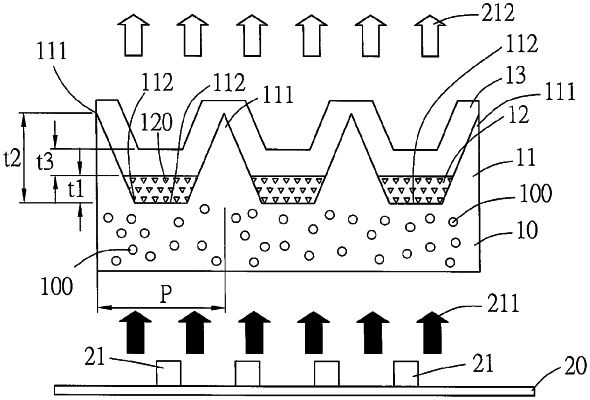| CPC G02F 1/01791 (2021.01) [G02F 1/133603 (2013.01); G02F 1/133606 (2013.01)] | 16 Claims |

|
1. A quantum dot light diffuser plate capable of being assembled on a backlight module with a plurality of blue light emitting diodes (LEDs); the backlight module comprising a substrate and the blue LEDs arranged on the substrate in an array form; the quantum dot light diffuser plate being located above the substrate and comprising:
a plate body, having an upper surface and a lower surface; the lower surface facing the substrate;
a plurality of microstructures, formed on the upper surface of the plate body in an array form; the microstructures forming a plurality of convex portions and a plurality of concave portions on the upper surface of the plate body; the concave portions being separated by the convex portions, such that the concave parts are independent and not communicated with each other;
a quantum dot layer, disposed at the plurality of the concave portions on the upper surface of the plate body; wherein, a thickness of the quantum dot layer is t1, a distance from a top of the convex portions to a bottom of the concave portions is t2; wherein t1<t2; and
a water-blocking and gas-blocking layer, disposed on the upper surface of the plate body and covering the plurality of the convex portions and the quantum dot layer;
wherein, the plate body comprises one of the following material: polycarbonate (PC), polystyrene (PS), polymethyl methacrylate (PMMA), polyethylene (PE), polypropylene (PP), polyethylene terephthalate (PET);
wherein, the plate body is formed by foam extrusion molding, and includes a plurality of microbubbles in the plate body; a weight reduction rate of the microbubbles to the plate body is 15-25%, and an average size of the microbubbles is between 60˜800 μm; wherein, a calculation formula of the weight reduction rate is:
weight reduction rate (%)=(W1−W2)/W2*100%;
W1=H*(L1*L2*D);
wherein:
H is an average thickness of the plate body (mm);
L1 is a length of the plate body (mm);
L2 is a width of the plate body (mm);
D is a density of a raw material of the plate body (g/mm3);
W1 is a theoretical weight (g) of the plate body, that is, the weight when the microbubbles are not included;
W2 is an actual weight (g) of the plate body, that is, the actual weight of the plate body containing a plurality of the microbubbles is actually weighed by a scale.
|